Menu
Table of contents
What exactly is keyword analysis?
Okay, a keyword analysis is the basics. But first, let's take a step back. Because what exactly is a keyword analysis and what does it look like? That can vary quite a bit, but in basic terms, it's very simple: a keyword analysis is a list of relevant words that people search for online.
Keywords and semantics
Before we begin the analysis, it is important to have some concepts clear. Semantics, for example. In SEO, semantics is crucial. In fact, Google goes beyond keywords. The algorithm understands the deeper meaning of search queries. To do that, it uses semantically related words, among other things. These are words that give meaning to a search word (or keyword).
Take "car" as an example. Semantic keywords could then be "sedan," "station," "vehicle," "gasoline," "steering wheel," "electric," and more. Using these semantic keywords helps to better match search intent, ultimately achieving higher positions in search results and more relevant traffic.
In short, keywords and semantics are inextricably linked in SEO.
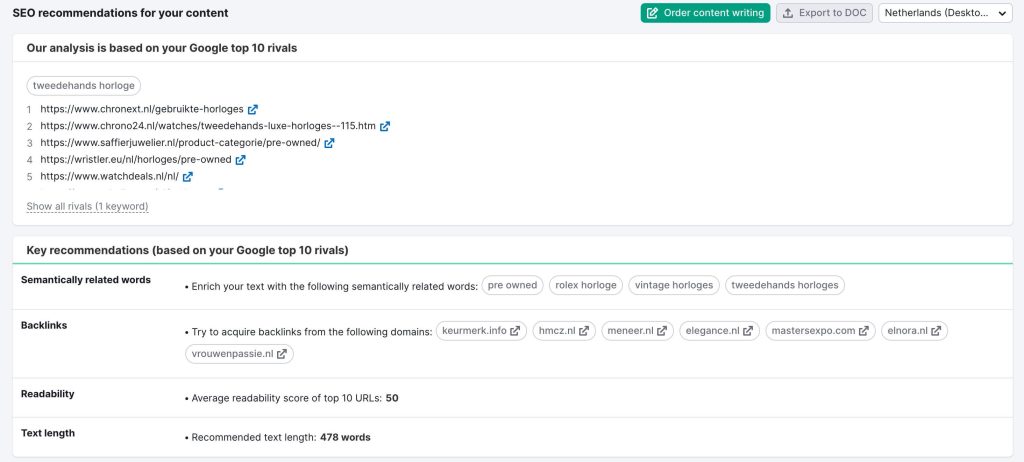
Tip: with the Semrush SEO writing assistant, you can find semantic keywords to go with a chosen keyword
Search Intentions
A keyword analysis is also about understanding search intentions. Search intentions can vary widely, even within a single keyword.
Let's take the keyword "engine" as an example. Behind this keyword there may be multiple intentions:
- A person may want to understand how an engine works (informational intent).
- Others may just want to know what an engine is (informational intent).
- Some are interested in buying a motorcycle
(bike) (transactional intent). - And still others specifically want to purchase motorcycle parts (transactional intent).
And so there are more examples to think of. Sometimes it can also be very obvious. For example, if someone searches for "Yamaha XT 700 Ténéré Rally Edition" , it is probably about a buying intention. It is important to take intent into account. That way you can better tailor your Web site to the searcher's query.
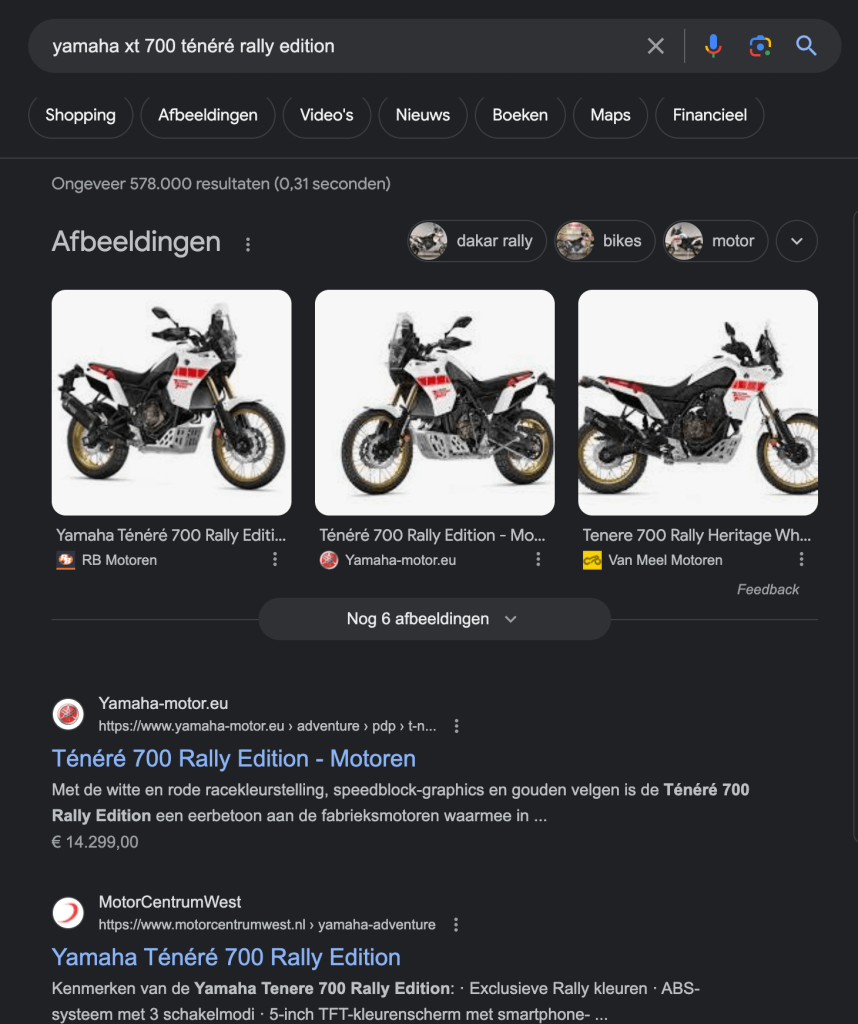
Tip: Just Google the keyword and see what kind of content ranks well. That one probably best matches the searcher's intent!
Volume and difficulty
Volume (the monthly number of searches using a particular keyword) and difficulty (how easy/difficult it is to rank for a particular keyword) are also important terms to know.
There are several tools you can use to figure this out. Think Ahrefs, Semrush, KW finder and more. Note that these do not all give the same data. It varies. After all, it always remains an estimate and can also change. Especially with trending keywords!
Short tail and long tail keywords
They have actually passed the review now, but we have not yet mentioned them by name: short tail and long tail keywords.
Short tail keywords are short, general keywords with often high search volume, such as "laptop" or "coffee." They attract a lot of traffic, but are also very competitive.
Long tail keywords, on the other hand, are longer and more specific keywords (or whole phrases), such as "15-inch MacBook Pro price comparison" or "best coffee beans for espresso." They are a bit more targeted and therefore often have less search volume and less competition.
Which form is best? It depends. But basically, you always want to work with both.
Step 1: Diverge
Now it's time for the real thing. Diverging. By this we mean exploring a topic as broadly as possible.
This can be done by Googling, thinking logically, with the help of tools and by looking at competition. After all, better good copy than bad thinking. With all the keywords we are going to collect here, the goal is to end up with a sizable list.
1.1 Logical thinking
Is it really necessary to write a paragraph about this? Yes, I think so. Because this is a step that is often underestimated or even skipped altogether. If you are the owner of a webshop, you probably know your target audience inside out. So just think carefully about what your target audience would search for online and make a list of this. The more ideas, the better.
1.2 Tools
Ah, tools. Nice and easy. But you have to understand how to use them effectively. Daniel's favorite saying isn't "a fool with a tool is still a fool" for nothing.
Fortunately, there are tools that are easy to use. . Tools such as the aforementioned Ahrefs, Semrush and KW finder allow you to gather in search word suggestions, for example. Our favorite is Semrush, a versatile tool with many more features. A few examples of other tools are: the keyword sheeter, Alsoasked and the Google Ads keyword planner.
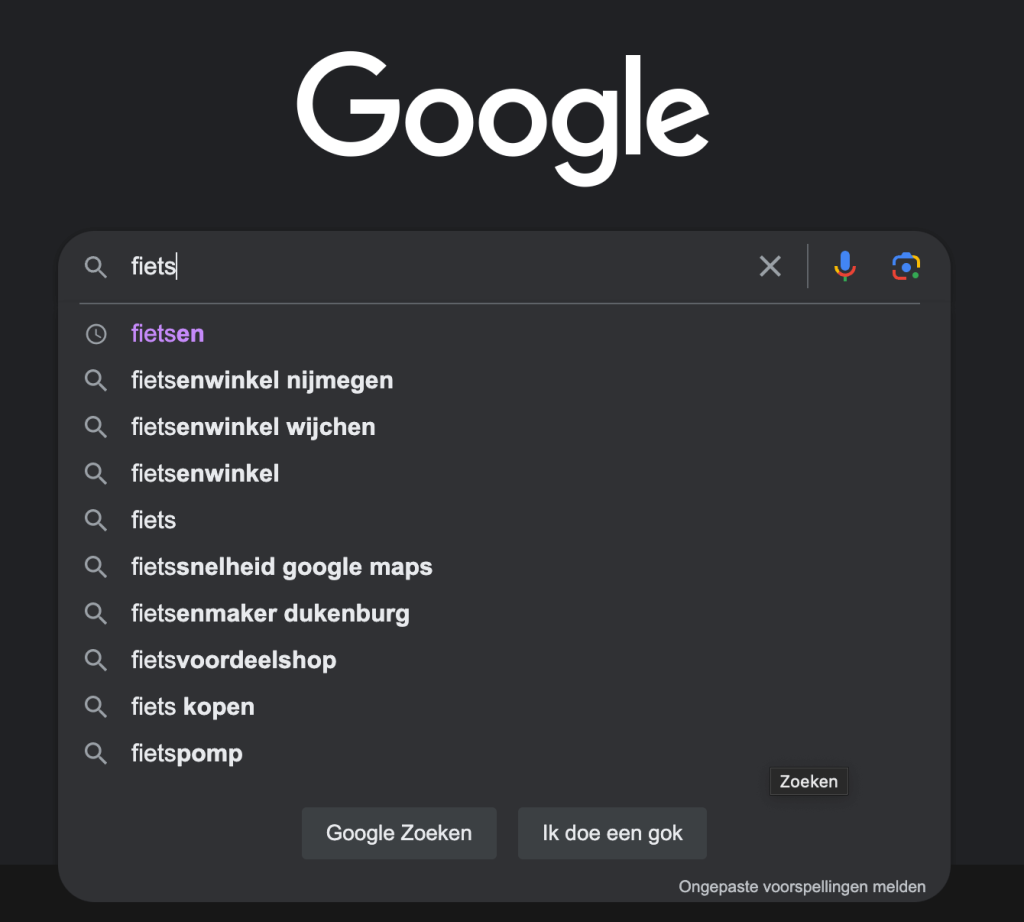
Tip: also try the google search term suggestions, free and for nothing
1.3 Combining words
By combining words, you can find many interesting keywords. This can be very useful for your keyword analysis.
In the image below, an example. Suppose you have the word "clothing. You can enter things like women's, men's, yellow, green, luxury, etc. for that. But also things like sizes S, M, L and XL. Or you combine it with brands: Stone island, Nike, Adidas etc. But you can also combine your keyword with city names, for example. And so there are more combinations possible.
This way you can easily diverge and create a list with lots of interesting keywords
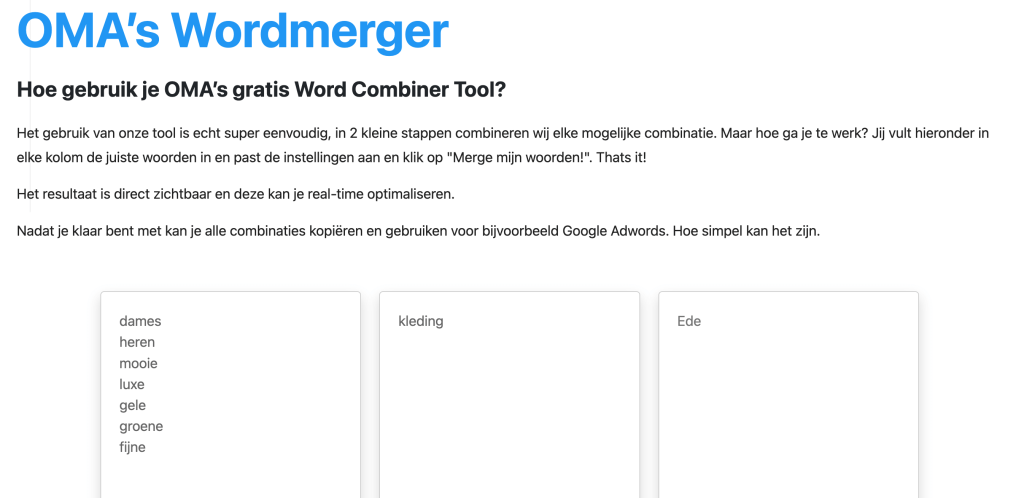
Tip; Use OMA's Wordmerger to combine words
1.4 Competitive research and content gap analysis
It is also helpful for competitive research to simply do some Googling. Look at how competitors have set up their Web sites. What they rank for. And include these keywords in your keyword analysis if they are relevant.
With tools like Semrush, you can perform a content gap analysis. This allows you to go even deeper into competitors and their search terms. You simply compare the search terms of your website with those of a number of competitors. Content gaps will appear: terms on which the competitor ranks, but you do not.
Step 2: Converge
In the previous step, we mentioned the basic means by which you can effectively collect as many keywords as possible. Therefore, if all goes well, you now have a list with a whole bunch of keywords. It is advisable to further process these in Excel (if you haven't already), because now it is time to make the list as relevant as possible by thinning it out.
2.1 Excel filters & functions
The first step is to deduplicate. With this handy feature in Excel, you make sure there are no more duplicate terms in your analysis. This is certainly much needed if you have been collecting heavily.
It is also useful to use the search function within Excel to remove certain terms (cmd F). This can also be done with a filter in a table within Excel. For example, suppose you have a web shop that sells paint. Then you would want to filter out all search terms with DIY stores (Gamma, Praxis, Hornbach, etc). This ultimately depends on what your business is and what you want to be found on.
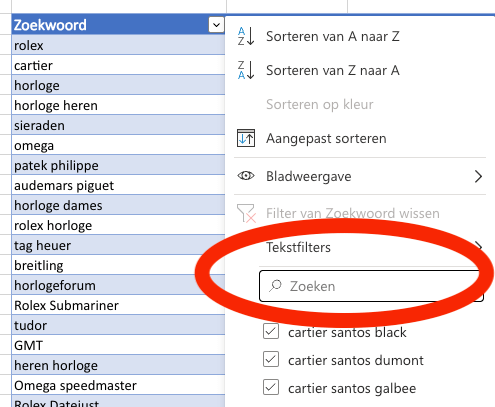
After inserting a table, you can filter by terms here. This way you can easily thin your list
2.2 Checking volume
With Semrush or one of the other tools it is possible to provide your entire list of keywords with data such as volume. In the case of Semrush you can do this through the keyword manager where you can check the search volume of up to2000 words at a time. All search terms with 0 volume are also included in your Excel list.
By filtering with a table and sorting it from high to low based on volume, you can easily pick out the words without volume. It is often wise to keep these words for a while. They can always come in handy later.
Step 3: Realize
If you have gone through the previous steps, you should have ended up with a good list of relevant keywords that are actually being searched for. The length of that list can vary greatly. Sometimes you have 100 interesting keywords and sometimes you have 5,000.
Most importantly, hopefully you now know which keywords to target. Choose keywords based on intent, that are relevant to your business , and that you can score on relatively easily.
Depending on the term, choose a blog, landing page or knowledge base article, for example. Be sure to check out our blogs for more information on these topics.
Optimize & observe
Once you've done your keyword analysis, written text and placed pages on your website, it's time for the next step: optimizing your (on page) SEO. Tools like Semrush can also help with this. For example, you can track how your rankings develop over time. They show you where there is room for improvement. Read our blog or listen to our podcast in which we discuss this topic.
Keep this in mind
Ultimately, keyword analysis is about responding to the demands of online searchers. So always, above all, keep thinking logically and try to understand your target audience. This really is of the utmost importance. Because by adding value, you will receive more value in return. And that's what it's all about in the end.











Written by: Igor van den Ende
Igor is an online marketer at OMA. With a black belt in karate as well as digital marketing, he wipes the floor with your online competition.